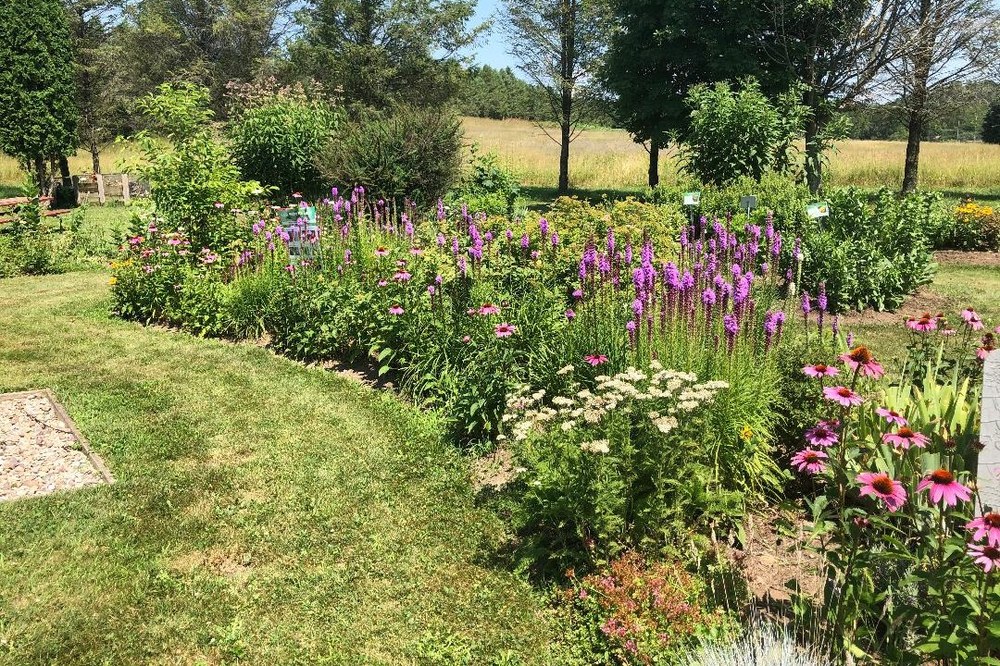Posted: May 11, 2021
The Penn State Extension Master Gardeners of Monroe County are planning a restoration project for the demonstration garden located at the Western Pocono Community Library in Brodheadsville. Read about the history and the future for the demonstration garden.

Photo by Joanne Fossett
An Old Demo Garden Gets a New Purpose
For more than twenty years, Master Gardeners in Monroe County have maintained a demo garden. The original location of the garden was Monroe County Area Vocational Technical School in Bartonsville. However, due to accessibility needs discrepancies between the Master Gardeners and the school, in August, 2000, the garden was relocated to property adjacent to the then newly-opened Western Pocono Community Library in Brodheadsville. It has remained there since.
The original plan for the garden included a variety of flowering herbaceous perennials, woody shrubs, and trees with annuals planted for special occasions such as the 100th anniversary of Penn State Extension in Monroe County. With its abundance of colorful flowers in bloom, textures, and symmetrical design, the garden was meant to beckon visitors to leisurely walk through to enjoy its beauty as well as learn the identity of the plants by reading plant labels posted within each of the garden's five beds.
Over the years, the Master Gardeners have experienced changes in membership. Naturally, these changes influenced changes to the demo garden. For example, beginning in 2014 Master Gardeners in Monroe County began participating in a Statewide research project called the Pollinator Preferences Study. Dedicated garden space is used to grow specific plants to monitor and record the occurrence of specific pollinating insects on the plants used in the study. Each study lasts for three years with Penn State determining the plants to be used and the insects to be monitored. The current study (began in 2020) is using four cultivars of goldenrod and one cultivar of Joe-Pye weed to record the attraction of over 35 species of butterflies. Additionally, with increased Master Gardener education and awareness about the importance of gardening with native plants, in 2016 two of the garden beds were cleared and made into native plant beds featuring a variety of native herbaceous perennials and shrubs. While maintaining signage to promote self-guided education to visitors, informal garden-side Master Gardener-led talks were also offered with topics ranging from routine garden maintenance to creating pollinator habitat.
Further changes in membership and the Coronavirus pandemic have influenced more changes for the garden. Expanding upon the use of native plants, beginning spring, 2021 planning has begun to redefine the demo garden's purpose to offer education to visitors (both in-person and virtual) about the environmental importance of habitat restoration with a focus on the special, critical role home gardeners can play in increasing biodiversity, and protecting water and air quality. Though in its infant stages, current plans include the conversion of two garden beds to sample garden meadows to be used to educate the public about the many ecological benefits meadows provide. At the same time by selecting plants to provide color and texture for all seasons that grow to no more than 4 feet tall, the hope is that visitors find the garden meadows visually appealing and will be inspired to include them, if possible, within their residential landscapes. Long-term plans may include the conversion of garden space to demonstrate habitat restoration in a suburban residential landscape setting. By using a small shed to mimic a house, the idea is to landscape around the shed using very little lawn and a variety of native plant species to show the habitat restoration benefits of vertical layering. Site-appropriate Keystone genera will be included to promote the importance of insect host plants. Conservation will be emphasized through the use of rain barrels and possibly a sampling of a pervious walkway. Additional habitat to be featured throughout the garden is to include shelter for toads, bare earth patches, and piles of rocks, sticks, and leaf litter to demo nesting and overwintering sites for bees, moths, and beetles.
The intention is to educate visitors to understand that restoring habitat within their landscapes provides many important benefits to wildlife and people alike. By paying as much attention as possible to visual appeal, the hope is that the demo garden's appearance will challenge the common-place stigmatizing notion that landscaping with native plants and habitat restoration areas are weeded and messy community eyesores and, over time, may inspire even the most "turf-centric" homeowners to increase wildlife habitat in their outdoor living spaces.

